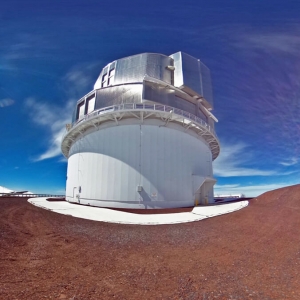Social media went awry on Sunday, April 17, after thousands reshared a video clip of what looked like a swirling ball of light gliding over the summit of Maunakea. The eerie footage was captured just after 5 p.m. Hawaiʻi time by a livestream camera mounted on the Subaru Telescope. Many onlookers labeled the strange sighting a “flying whirlpool” and pondered whether it was connected to some sort of extraterrestrial spacecraft.
Experts like J.D. Armstrong, an education and outreach specialist at the University of Hawaiʻi Institute for Astronomy (IfA) quickly put E.T. theories and hoopla to rest after explaining the object was in fact part of a SpaceX Falcon 9 rocket launched earlier that day from the Vandenberg Space Force Base in California. SpaceX was founded in 2002 by Tesla CEO Elon Musk with the goal of decreasing space transportation costs.
“This is the upper stage of the rocket, it’s like the second section up and as they’re burning off fuel looks like this upper stage is spiraling end over end and it’s tumbling and it’s creating a spiral pattern similar to a pinwheel firework,” Armstrong explained.
UFO or meteor shower

In October 2020, thousands were mesmerized by a mysterious flurry of lights that appeared to float across Hawaiʻi’s evening sky. Photos and videos flooded social media, leaving many to believe the sighting could be anything from a spaceship to a meteor shower. According to IfA astronomers and experts across the globe, what onlookers were actually witnessing was the reentry of a spent rocket booster used to launch a Venezualan satellite.
- Related UH News story: UFO spotted over Hawaiʻi likely spent rocket, October 26, 2020
Astronomical phenomena caught on Subaru’s Asahi Sky Camera have captivated virtual stargazing audiences before. In August 2021, the camera, installed to give the globe a glimpse of the skies over Maunakea, captured livestream footage of more than a dozen meteors streaming from the same direction within a 10-second window. Astronomers from Subaru’s 8.2-meter telescope described the non-hazardous event as a rare meteor outburst associated with a “meteoroid cluster.” Only a few cases have been reported since the phenomenon was first identified during the Leonid meteor shower in 1997.
- Related UH News story: Rare meteor outburst captured by Maunakea telescope, August 3, 2021
Tracking asteroids
Telescopes on Maunakea and Haleakalā also play a critical role in tracking potentially hazardous asteroids and assist with rapid follow-up observations to verify an asteroid’s orbit and if it poses any threat to Earth.
This effort is an example of UH Mānoa’s goal of Excellence in Research: Advancing the Research and Creative Work Enterprise (PDF), one of four goals identified in the 2015–25 Strategic Plan (PDF), updated in December 2020.

